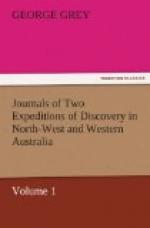We stood on until eleven A.M.; but in making land there always rests a certain degree of anxiety upon the mind of the seaman and traveller, more especially when that land is imperfectly known. As there appeared to be every chance of our losing the sea-horizon, and consequently our noon observation, if we stood on and the breeze continued, our course was changed to the other tack until that hour; and then having correctly ascertained our position, Red Island bearing south-east by east, distance 8 miles, we once more stood in for the land.
Red Island is small, rocky, and of no great elevation; its colour is a very dark red; the sides are precipitous, and in its centre is a clump of trees which cannot be seen until you have run by the island, as it falls gradually from the south-west to the north-east, so that the north-east side is the least elevated. We sounded when about seven miles to the north-west of it, and found bottom at twenty-five fathoms, of green sandy mud.
The sandbank laid down on the Admiralty charts to the north-east of Red Island is small and barren; it is very low, and at some distance looks like a white rock in the water; being apparently an island formed of the same rock as the former, and topped with quartz or white sand. In entering Hanover Bay, or Port George the Fourth, a good course is to run nearly midway between this and Red Island. At sunset we anchored off Entrance Island (Port George the Fourth) in twenty-five fathoms water.
Arrival off the coast of Australia. Aspect of the country from ship-board.
At the first streak of dawn I leant over the vessel’s side to gaze upon those shores I had so longed to see. I had not anticipated that they would present any appearance of inviting fertility; but I was not altogether prepared to behold so arid and barren a surface as that which now met my view. In front of me stood a line of lofty cliffs, occasionally broken by sandy beaches; on the summits of these cliffs and behind the beaches rose rocky sandstone hills, very thinly wooded. Whilst I mused on this prospect, all hands were busied in getting the vessel under weigh, which was soon accomplished; but there was little or no wind, and the ship lay almost motionless upon the waters.
Land at high bluff point. Walk to Hanover bay.
By ten o’clock however we were abreast of High Bluff Point and, as there appeared to be little chance of our having even a gentle breeze for some time, I determined to land with a party at the Point, and to walk from thence to Hanover Bay, where on our arrival we could make a signal to the vessel for a boat to reconvey us on board. By the adoption of this course I hoped to be able at once to select a spot affording water and forage, in the neighbourhood of which the sheep and stores might be landed; the vessel could then proceed without delay to the Island of Timor to procure the requisite number of ponies for our expedition, and, if she made a quick passage there and back, I trusted, notwithstanding the numerous unforeseen delays that had arisen, we might yet be able to start for the interior before the rainy season set in.




